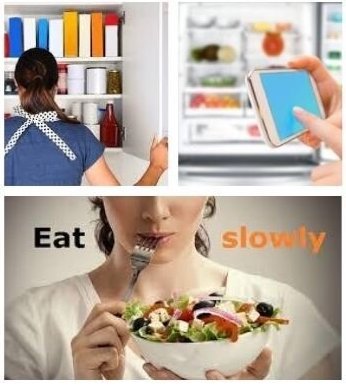Three Experiments To Help Change Your Nutrition Habits
As New Zealand is now in what we affectionately term Lockdown 2.0 - whether you are at Level 2 or Level 3 - most of us have said or written the words ”this time it will be different”. I know I have!
We have possibly promised ourselves we would stop eating chippies, chocolate and ice-cream. Or drinking wine. Or ordering delivery eats most nights of the week.
We have said that this time around our willpower is strong and we can do this!
So how is that working out for you? Are you doing it? Can you do it?
If there is a tub of ice cream in my house, I think to myself “I’ll just have one spoonful”.
Spoiler alert…I lie to myself. I cannot be around ice cream. It is the nectar of the gods to me. That tub is empty before I know what I have done.
And then I tried my first experiment. Because it wasn’t my willpower that was the problem, it was my kitchen. More importantly, it was what I had in my kitchen. The foods that I had bought prior to lockdown or even at the start that was supposed to be ‘just a little treat’. See, we all do it, even us Nutrition Coaches!
Experiment 1 - The Kitchen Makeover
Use this two-step process to clean out your fridge, pantry, freezer, and other places you stash food. In the process, you’ll make some foods a lot harder to eat and other foods a lot easier to eat.
Step 1: Make A List
Determine your red, yellow, and green light foods.
Here’s how to identify yours:
Red light foods = “no go” foods.
These are foods that present such a difficult challenge for you that they just aren’t worth the struggle. These can also be different for different people. As I said before, I can’t keep ice cream in the house but chocolate biscuits don’t get touched for ages.
Red light foods may not work for you because:
They don’t help you achieve your goals
You always overeat them
You’re allergic to them
You can’t easily digest them
You just don’t like them
Ultra-processed foods often fall into this category.
Yellow light foods = “slow down” foods.
Maybe you can eat a little bit of these and stop, or you can eat them sanely at a restaurant with others, but not at home alone.
Green light foods = anytime foods.
They’re nutritious and make your body and mind feel good. You can eat them normally, slowly, and in reasonable amounts. Whole foods usually make up most of this list.
Step 2: The Clear Out
You’ll probably need a garbage bag and a compost bin if you have one.
First, get rid of the red-light foods. If you struggle with the idea of wasting food, consider donating unopened, non-perishable, unexpired items to a charity. Compost what you can’t donate.
And remind yourself: Overeating is no less wasteful than trashing the food, given your body doesn’t actually need the calories. Your kitchen purge may actually save you money over time because you’ll stop buying certain foods.
Next, deal with the yellow light foods.
You have a few options here. You can remove them, keep them in smaller quantities to prevent overeating, or put them somewhere hard to see and reach (on a high shelf in an opaque container, for example).
Lastly, stock up on your green light foods.
Put these foods front and centre and take steps to make them easy to grab and eat.
One note: Don’t overdo it when purchasing new green foods, especially produce, as they’re likely perishable (unlike most of the red and yellow foods you’re replacing). Remember, it’s okay to start small and build from there.
Step 3: Take Notes.
The next time you get a craving for a red or yellow food, notice what happens.
Do you reach for something on your green light list, since that’s what’s right in front of you?
Or do you drive to the store to get food you crave?
Or… do you decide not to eat anything at all because it requires way too much effort?
The lesson here is that our environment makes it harder to practice healthy eating habits.
And we learn that throughout our journey - in the Mind Prep videos, at Retreat, in some of our Consultations with the WLS team. Understanding this, and that our environment guides our decisions means that we can start to take better actions.
If a food is in your house or possession, either you, someone you love, or someone you marginally tolerate, will eventually eat it. BUT this also means that if healthy food is in your house or possession, either you, someone you love, or someone you marginally tolerate, will eventually eat it.
Experiment 2 - For One Week, Track Everything You Eat
All you have to do: Write down what you eat every day for a week.
Yeah, yeah, yeah. You’ve heard this advice before—maybe hundreds of times. But you’ve also seen that I do it, every day. Have you really done it? Actually writing it down (versus keeping a mental tally)?
For every single meal and snack? Every day? For a whole week?
If not, give it a try. It’s actually a lot easier than it sounds. You can write it down in a notebook, use a record-keeping app like MyFitnessPal, or even just snap a photo of everything you eat.
Make sure to include everything you eat and drink. And then treat these notes as if you were a scientist. This isn’t about judging your food choices. It’s merely about noticing them. Be kind, curious and compassionate with yourself.
At the end of the week, take a look at your log. Is it in line with how much you thought you were eating?
The lesson is that it is really, really easy to underestimate how much you eat. And to forget the nibbles and bites and sips that we take throughout the day.
Experiment 3 - Eat Slowly Every Day For A Week, Trying To Make Every Meal Last A Little Bit Longer
(Start by taking a breath between bites)
What it reminds us is that we feel more satisfied sooner, so you eat less automatically.
You may also notice eating slowly brings up uncomfortable feelings—ones you’ve been quashing with food.
Using this approach, in combination with mindful eating practices like eating slowly and to 80 percent full, can help you eat in a way that makes weight loss and personal accountability feel more effortless.
By simply paying attention to how experiments make you feel, you empower and energize yourself to make better, more informed choices. And remember: Self-experimentation isn’t about getting it perfect. It’s about finding out what works for you, and then putting it into practice—one small step at a time.
Yes - absolutely I can help and we can work through these experiments together.
Find me at http://www.allergictosugar.co.nz
Join me for the next 12 Days of You Project

